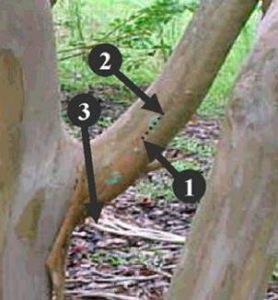Structural Pruning
Pruning is all about perspective. What are your pruning goals? Consider your objective and take a few laps around your tree to get a better idea of what you want to do while prioritizing structural problems. Imagine the branches on the tree in 3 years or 5 years when you come back to prune again. Remember, when pruning a tree, remove less than 20% of the canopy in one year. You won’t accomplish everything this season- choose wisely.
Although the best time to prune trees is the winter, summer foliage allows you to see dead wood and new growth directions more clearly.

 Don’t forget the proper pruning cut, just outside the branch collar. The proper pruning cut will trigger healing hormones to seal around the cut and protect your tree from decay.
Don’t forget the proper pruning cut, just outside the branch collar. The proper pruning cut will trigger healing hormones to seal around the cut and protect your tree from decay.